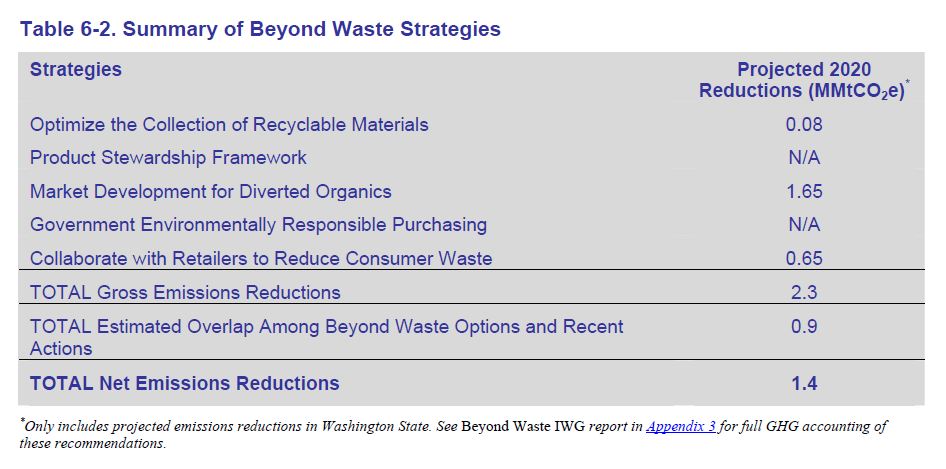
Jurisdiction: Washington State
Plan Year: 2008
Update Year: 2010
Progress Report Years: 2010, 2012
Background:
In 2007, Governor Christine Gregoire signed Executive Order 07-02, which states that Washington must reduce emissions to:
- 1990 levels by 2020
- 25% below 1990 levels by 2035
- 50% below 1990 levels by 2050
In 2008, Washington State Department of Ecology and Washington Community, Trade, and Economic Development, under the direction of Governor Gregoire, developed a Climate Action Plan. The plan was created under the direction of an appointed Climate Advisory Team (CAT), which was served by Technical Work Groups (TWG), including a combined Agriculture and Waste TWG. A “Beyond Waste” Implementation Work Group (IWG) also provided recommendations related to reducing GHG emissions through increased recycling, reuse, and anaerobic digestion.
The CAP was updated in 2010 by the Washington Departments of Ecology, Commerce, and Transportation (WSDOT) and focuses on the emissions reductions required by 2020. The original strategies in the 2008 CAP were designed around Western Climate Initiative’s emissions trading program, which limits GHG emissions and relies on the market to determine how best to achieve those reductions at the lowest cost. However, when state and federal lawmakers did not adopt the emissions trading program, Washington State determined other ways to work with state and federal partners to achieve its emissions reduction targets sector-by-sector. The 2010 CAP does not make significant mention of the sustainable materials management strategies that were part of the original 2008 plan.
Many elements of the CAT’s Beyond Waste recommendations were incorporated into the State’s revised and updated Beyond Waste Plan, which aims to: “eliminate wastes and toxics whenever we can and use the remaining wastes as resources.” The 30-year plan, which was being updated at the time of this writing, states:
“Avoiding wastes and the use of toxic chemicals is the smartest, cheapest, and healthiest approach to waste management. The Beyond Waste Plan shifts from a reactive approach, focusing on management and clean-up, to a proactive approach, with an emphasis on preventing waste in the first place.”
Materials Management Goals:
- Increase statewide recycling rate to 80%
- Develop a market for diverted organics
- Promote environmentally preferable purchasing programs in government
- Work with retailers to reduce consumer waste
Strategies:
- Develop product stewardship framework
- Optimize the collection of recyclable materials
- Expand Washington electronics recycling program to other products, such as carpet, paint, rechargeable batteries, and mercury-containing lighting and thermostats
Progress Report:
Washington State has issued two progress reports on efforts to reduce greenhouse gas emissions within state government operations. It has not reported on community achievements to reduce GHG emissions based on actions outline in its 2010 comprehensive plan.
In its 2010 progress report on state operations, Washington State reported on the status of waste reduction and environmentally preferable purchasing efforts, highlighting the following:
- All state agencies are implementing Paper Conservation Action (2009) which means they are using high recycled-content paper and reducing their paper use
- 85% of agencies established recycling or resource conservation programs
- 2/3 of state agencies followed the Environmentally Preferable Purchasing (EPP) guide
- 52 agencies started composting organic materials since 2005
Next Steps:
Washington State’s 2013 Legislature passed an act to develop recommendations to achieve the state’s GHG emissions reduction targets. The Climate Legislative and Executive Workgroup issued a report in January 2014 that found that existing state and federal policies will enable the state to make progress over halfway toward its 2020 emission goals. The group identified a set of actions that could achieve the additional emissions reductions needed to meet the 2020 target. While the state’s climate comprehensive plan has not been updated, the Beyond Waste plan was being updated again at the time of this writing in 2014.
Links:
- Path to a Low-Carbon Economy: An Interim Plan to Address Washington’s Greenhouse Gas Emissions (December 2010)
- Reducing GHG Emissions in Washington State Government: Second Biennial Progress Report (December 2012)
- Reducing GHG Emissions in Washington State Government: First Progress Report (December 2010)
- Growing Washington’s Economy in a Carbon-Constrained World A Comprehensive Plan to Address the Challenges and Opportunities of Climate Change (December 2008)
- Beyond Waste
